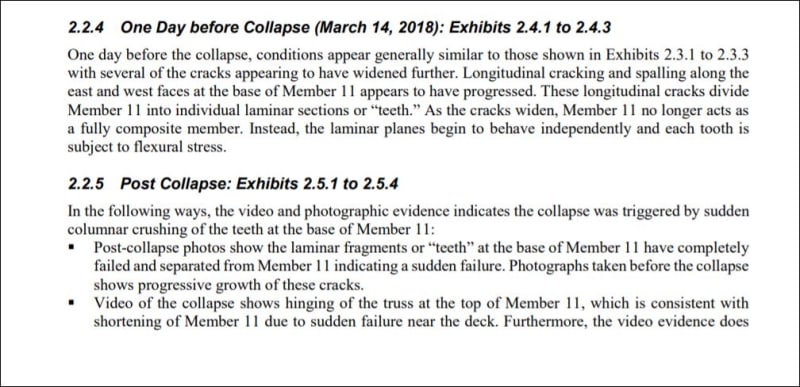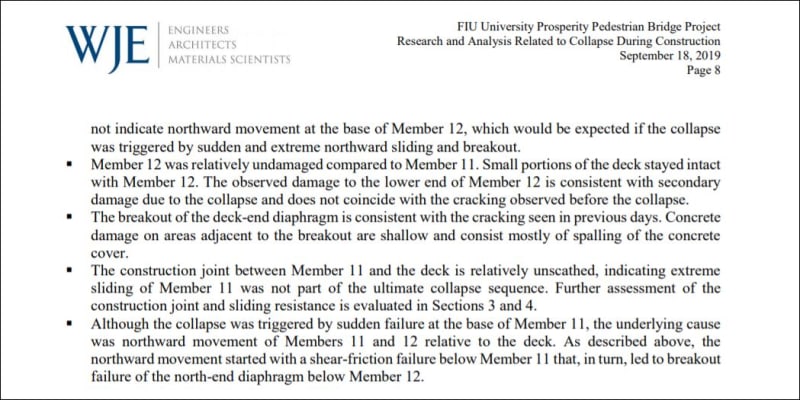Thoughts on WJE Report
The WJE report is a pretty good document. It presents tests of sloping construction joints under shear friction.
But they used Chicago Aggregates and not Florida aggregates, a different supplier of Portland cements and Slag cements, and a different Portland cement to Slag cement ratio. Why would you do that? This is a problem with consequences beyond $50 million - how much does it cost to truck a few tons of cement and aggregate to Chicago?
Think of FIGG being able to stand up in court and say we tested the design under full scale tests using EXACTLY the same aggregates, EXACTLY the same cements, and EXACTLY the same quantities of those EXACT components in our testing so these test results directly prove our design is correct.
Now they have to convince the jury their test is even applicable. They will need to say the results are adjusted by some factor so they can apply to the FIU case - which factor will also have to be explained and sold to the jury. Heck, why not just apply an "Its Not My Fault" factor and be done with it?
I did learn something about shear friction action. The concept that reinforcing across the shear plane contributes to the capacity of the joint seems to be validated. The action seems to correlate well with the 45 degree idea of inducing tension in that reinforcing. It was previously presented here that #7 bars at 12D development lengths could result in a stretch of 0.026 inches at 57,000 psi (0.90X yield) and that would be 0.030 inches at yield. The slip of the tested joints was noted to be 0.02 inches at maximum load, suggesting the #7 cross plane reinforcing developed yield at development lengths closer to 8 diameters. I can buy that. That could explain how the 3 pairs of bars in the #7 hoops in node 10/11 developed enough tension to fail. The WJE analysis looks at strut action with bearing to add the contribution of the bend to the anchorage.
I also see that ANY laitance must be removed - and any paste only matrix. The particles in the paste matrix seem far too small to effectively contribute to a perpendicular movement of 0.020 inches and thereby mobilize the cross plane reinforcing.
The test results seem to support FIGG's position that the failure to prepare the surface of the deck under node 11/12 is why the structure collapsed.
Then the Structural Analysis by WJE finds that the capacity of the joint as NOT intentionally roughened was about equal to the demand at the time of collapse. Add to that prior cracking and movements from moving and the results are now clear. Hindsight is 20/20. The WJE analysis seems to be much different than the analysis by FHWA/NTSB which, as I read it, suggests the FIGG calcs are off by almost 100%.
The WJE analysis suggests that correct preparation of the deck surface at node 11/12 would have resulted in a condition that was completely adequate for this phase of the project.
The following is from the WJE report, Page 127.
9 SUMMARY OF FINDINGS AND CONCLUSION
The following summary of findings and conclusion follow from the research and analysis described in
Sections 2 through 8 of this report. The section that relates to each conclusion is indicated.
Failure Pattern (Section 2). A debonding and sliding failure at the construction joint below Member 11
led to breakout failure of the north-end diaphragm and ultimately collapse, triggered by sudden crushing of
Member 11 near its base.
Construction Joint Conditions (Section 3).
Despite FIGG’s confirmation to MCM that the FDOT Standard Specifications requiring roughening of the hardened concrete must be followed, the construction joint surface below Members 11 and 12 appeared to have been left in an as-placed (non-roughened), relatively smooth condition.
Interface Shear Transfer Testing (Section 4).
The primary finding from the experimental program is that intentional roughening of the construction joint following FDOT Standard Specifications improved the shear capacity of the cracked interface by a factor of 1.78. This factor reduces by 5 to 13 percent if adjustment for Florida aggregate is made based on slant shear tests. This finding is consistent with relative difference according to the AASHTO Code: the maximum allowable shear stress for a roughened surface (1.5 ksi) is 1.88 times that for a non-roughened surface (0.8 ksi).
Comparison of observed axial strengths of the as-placed (non-roughened) specimens to the calculated force
in Member 11 after the shoring was removed suggests that the construction joint was weakened or at least
partially debonded when the shoring was removed.
More significantly, the axial capacities of the roughened specimens, before or after adjustment for Florida
aggregate, are substantially greater than the calculated axial force in Member 11 at the time of the collapse.
As such, if the construction joint were roughened as required by the FDOT specifications, the collapse
would not have occurred. This conclusion is valid for hardened concrete surfaces intentionally roughened
in accordance with FDOT Standard Specifications even if the surface roughness is considered to be less
than the 1/4 inch amplitude referenced in the AASHTO Code. Also note that this conclusion neglects the
additional capacity from breakout resistance of the north end diaphragm, which if included would provide
additional capacity to the connection.
Structural Analyses (Section 5).
A finite-element model of the main span was developed to determine truss member forces and bending moments during construction.
AASHTO LRFD Design Compliance.
The Member 11/12 deck connection was evaluated in accordance with the AASHTO Code, assuming resistance by shear-friction across the entire construction joint.
Although inconsistent with the actual failure mode, resistance by shear-friction across the entire
construction joint is the likely design assumption. Based on WJE test results, the AASHTO friction
coefficient for a roughened surface (which calls for 1/4-inch roughness amplitude) was assumed. However,
AASHTO does not provide specifics on preparation of the joint (including intentional roughening of
hardened concrete) or how roughness is measured. The FDOT Standard Specifications, as proven by
laboratory testing, achieves the requirements of AASHTO Code. The capacity-to-demand ratio was found
to be 1.09 if AASHTO load modifiers for ductility and redundancy are excluded, and 0.99 if they are
included, indicating compliance with AASHTO design requirements.
The following is WJW Report page 128.
Capacity Analysis for Observed Failure Pattern.
The Member 11/12 deck connection was also evaluated
based on results of the interface shear transfer testing in combination with breakout resistance consistent
with the actual failure pattern, ACI 318 design equations, and related research. The results indicate that the
combined shear-friction and breakout resistance is consistent with the calculated horizontal force in the
Member 11/12 deck connection at the time of the failure. This explains the failure due to the unroughened
construction joint surface.
Evaluation of Peer Review (Section 6).
Berger’s peer review fell far short of their contractual obligations.
In particular, by their own admission, Berger did not even attempt to assess the conditions at the
construction stage shown in the plans that was being built at the time of the collapse, which was required
by their contract. Furthermore, the Berger finite element model could not have been used to reasonably
estimate the forces in the concrete truss members during construction or in the structure’s final
configuration because it did not address the construction phasing.
Evaluation of Twist Exceedances during the Main Span Transport (Section 7).
Cracks in the region of the connection of Members 11 and 12 to the deck increased dramatically after the move from the casting yard to the final location, as evidenced by photographs taken before and after the move. The deformations associated with exceeding the established twist limits caused high stresses in the region. Along with other factors, this stress may have been a contributing factor to damage in the region and ultimately to the
collapse.
Re-Stressing of Member 11 (Section 8).
Contrary to FIGG’s instructions, no one closely monitored cracks in the north-end diaphragm during re-stressing of Member 11, even though both MCM and Structural/VSL were aware of the instruction. Also, Structural/VSL’s shop drawings state that stressing operations should stop if existing cracks widen or new cracks are observed. Evidence shows the construction joint was not roughened, so the existing cracks would have widened during re-stressing, and the widening could have been readily detected by several means. In accordance with FIGG’s instruction and Structural/VSL’s awareness of crack monitoring per their shop drawings, widening of the cracks would have required
stopping the re-stressing, thereby preventing the collapse.
Conclusion.
In conclusion, most significant finding from WJE’s research and analysis is that full-scale tests show that if the construction joint below Members 11 and 12 were roughened as required by the FDOT Standard Specifications, the collapse would not have occurred. It is also highly significant that, for the observed failure pattern and relatively smooth as-built condition of the construction joint, the combined shear-friction and breakout resistance determined from testing and analysis is consistent with the calculated horizontal force in the deck connection at the time the failure.
The WJE Report was prepared to support FIGG and seems to present that position pretty well.




